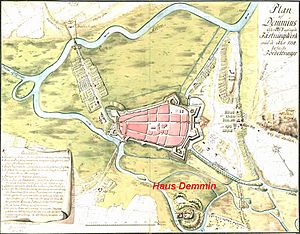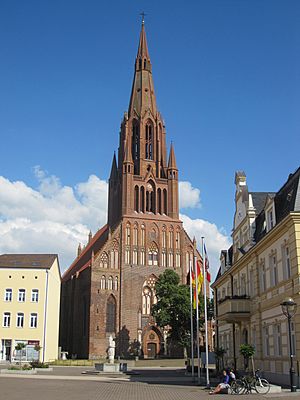Demmin facts for kids
Quick facts for kids
Demmin
|
|||
|---|---|---|---|
 |
|||
|
|||
| Country | Germany | ||
| State | Mecklenburg-Vorpommern | ||
| District | Mecklenburgische Seenplatte | ||
| Elevation | 8 m (26 ft) | ||
| Population
(2022-12-31)
|
|||
| • Total | 10,395 | ||
| Time zone | CET/CEST (UTC+1/+2) | ||
| Postal codes |
17109
|
||
| Dialling codes | 03998 | ||
| Vehicle registration | DM | ||
| Website | www.demmin.de | ||
Demmin is a town in the northeastern part of Germany. It's located in the Mecklenburgische Seenplatte area, which is part of the state of Mecklenburg-Western Pomerania. Long ago, it was the main town of the Demmin district.
Contents
Demmin's Location and Rivers
Demmin is found on a flat area called the West Pomeranian plain. It's special because three rivers meet here: the Peene, the Tollense, and the Trebel. You can even reach Lake Kummerow and the Szczecin Lagoon by boat from the Peene river.
The area where the Tollense and Trebel rivers join the Peene is often called the "Three Streams Land." This name is used for tourism and reminds people of ancient lands known for their rivers.
Forests and Nature Around Demmin
North of Demmin, you'll find the Drosedow Forest and the Woldeforst woods. There's also the Kronwald Nature Reserve, a protected area for plants and animals. To the west, across the Peene river, is the Devener Holz woodland. East of town are the Sandberg Pines, and to the southeast, the Vorwerk Forest.
Nearby Towns and Villages
Demmin is surrounded by several other towns and villages. To the north are Nossendorf and Loitz. To the east, you'll find Kletzin, Siedenbrünzow, and Utzedel. South of Demmin are Beggerow, Borrentin, and Schönfeld. To the west lies Warrenzin.
Parts of Demmin Town
Several smaller villages are also part of Demmin. These include Deven, Drönnewitz, Erdmannshöhe, Karlshof, Lindenfelde, Randow, Seedorf, Siebeneichen, Vorwerk, Waldberg, Woldeforst, and Wotenick.
Demmin's Long History
How Demmin Got Its Name
The name Demmin might come from an old Slavic word, timänie, which means 'swampy area.' Another idea is that it comes from dym, meaning 'smoke,' referring to how people cleared land by burning it to build settlements.
In 1075, a writer named Adam of Bremen mentioned a fight over a castle called Dimine. Over time, the name changed to Dymine, Dimin, and then Dyminium in Latin. Finally, around 1320, it became known as Demmin, which is how we spell it today.
There's a fun story, but it's not historically true, about the name. It says two princesses built a castle called Haus Demmin. They supposedly said in Low German, Dat Hus is din und min, meaning 'That house is thine and mine.' This story claims the name of the castle and town came from that phrase.
Ancient Times in Demmin
People lived in the Demmin area a very long time ago, even as early as 5500 to 4900 BC. This was during the Stone Age, when the Linear Pottery culture spread here. There are also many ancient stone structures called Megaliths, like the great dolmen near Upost. These show that the Funnelbeaker culture lived here too.
From about 1800 BC, Germanic peoples started settling in the area.
Demmin in the Middle Ages
Slavic people, called the Veleti, settled in the forests around Demmin as far back as the 8th century. In 789, during the Saxon wars, Charlemagne led his army to the Peene river against the Veleti. Their king, Dragovit, gave up and promised loyalty to Charlemagne.
This area was a great place to settle because it was at the meeting point of rivers and trade routes. A border castle was built around the 10th century by the Lutici people. This castle was later called "Haus Demmin." It helped control the eastern parts of a territory called Circipania.
Demmin was a very important place for the West Slav Circipanes during the Middle Ages. Because of its key location, strongholds were built (and often attacked and destroyed) at places like Vorwerk and Haus Demmin. These were known as Dimin or Dymin.
In the early 12th century, the Polish ruler Bolesław III Wrymouth brought Christianity to Pomerania. He asked Otto of Bamberg to help, and Otto visited Dymin in 1127. The people accepted Christianity, and a church was built in 1140.
In 1147, a Saxon army tried to capture Demmin but failed. In 1160, Dymin became the capital of its own small duchy. It was captured by Henry the Lion in 1164 but was soon rebuilt. In 1177, it was successfully defended against another attack by Henry the Lion.
In 1211, King Valdemar II of Denmark captured Demmin and held it until 1227. In 1264, it became part of the Duchy of Pomerania again.
Demmin was given town rights in the 13th century. These rights were confirmed by Dukes Bogislaw IV, Barnim II, and Otto I in 1292. People from Germany and Flanders moved to Demmin between the 13th and 14th centuries.
After Pomerania was divided in 1295, Demmin became part of the Wolgast dukes' land. In 1326, Duke Otto I allowed all merchants coming to Demmin to be free from customs duties and taxes. In 1327, Mecklenburg tried to capture Demmin but failed. From 1478, Demmin was part of the reunited Duchy of Pomerania.
Demmin in Modern Times
Like most of Pomerania, Demmin and its surrounding areas were mostly rural and focused on farming for a long time. Even though Demmin was a member of the Hanseatic League (a powerful group of trading cities), its rivers connected it to the Baltic Sea coast, which helped with trade.
During the Thirty Years' War, Demmin was taken over by imperial forces from 1627 to 1630. After that, Swedish forces occupied it. From 1648, Demmin was part of Swedish Pomerania. In 1720, it became part of Prussia. In 1807, French forces briefly occupied it. By the late 1800s, people in Demmin mostly worked in weaving, tanning leather, fishing, and trading.
In the early 20th century, Demmin had strong support for certain political groups. Before 1933, there were actions against Jewish businesses, which caused many Jewish people to leave. The local synagogue was sold in 1938, which is why the building still stands today. On November 11, 1938, a large gathering took place in the town square.
During World War II, people from other countries were forced to work in Demmin.
As World War II ended, German troops destroyed the bridges over the Peene river. This slowed down the Soviet Red Army when they arrived in Demmin on April 30, 1945. Demmin was handed over to the Red Army mostly without a fight. From 1945 to 1952, Demmin was part of the state of Mecklenburg-Vorpommern. From 1952 to 1990, it was part of East Germany. Since 1990, it has been part of Mecklenburg-Vorpommern again.
Demmin's Coat of Arms
The coat of arms of Demmin tells a story about the town:
- It shows a red fortress with three open gates.
- The two towers of the fortress have a silver lily on top.
- There's a silver shield leaning to the right, with a red griffin on it. The griffin is a special animal that represents Pomerania.
- On top of the shield, there's a crowned blue helmet with green peacock feathers.
- The red fortress reminds us that Demmin was once a home for Pomeranian princes.
- The lily on the towers represents the city's flower from the 18th century.
Famous People from Demmin
Many notable people have come from Demmin:
- Joachim Lütkemann (1608–1655), a Lutheran theologian and writer.
- Heinrich Carl von Schimmelmann (1724–1782), a successful merchant, banker, and politician.
- Julius Friedrich Cohnheim (1839–1884), a famous pathologist who studied diseases.
- Hans Joachim von Rohr (1888–1971), a politician.
Sports Stars from Demmin
Demmin has also produced several talented athletes:
- Otto Kuchenbecker (1907–1990), a basketball player.
- Ilona Slupianek (born 1956), a shot putter who won a gold medal at the 1980 Summer Olympics.
- Ellen Fiedler (born 1958), a hurdler who won a bronze medal at the 1988 Summer Olympics.
- Axel Wegner (born 1963), a sport shooter who won a gold medal at the 1988 Summer Olympics.
- Torsten Krentz (born 1966), a sprint canoeist.
- Stefan Uteß (born 1974), a sprint canoeist who won a team bronze medal at the 2000 Summer Olympics.
- Heike Fischer (born 1982), a diver who won a team bronze medal at the 2008 Summer Olympics.
See also
 In Spanish: Demmin para niños
In Spanish: Demmin para niños







